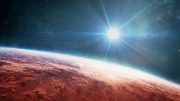
The ultra-hot giant exoplanet WASP-76 b, studied here, is an extremely hot world orbiting very close to its giant star. Credit: International Gemini Observatory/NOIRLab/NSF/AURA/J. da Silva/Spaceengine/M. Zamani
An international research team, using the MAROON-X instrument, has detected and quantified 11 chemical elements in the ultra-hot exoplanet WASP-76 b’s atmosphere. Unexpected abundance anomalies of these elements suggest the planet may have absorbed a smaller, Mercury-like planet. The team’s study also demonstrates the significant temperature sensitivity in the composition of giant planet atmospheres.
NYU Abu Dhabi Research Scientist from the Center for Astro, Particle, and Planetary Physics Mohamad Ali-Dib, along with an international team led by the Université de Montréal, recently announced a detailed study of the extremely hot giant exoplanet WASP-76 b in the journal Nature.
Thanks to the MAROON-X instrument on the Gemini-North Telescope, the team was able to identify and measure the abundance of 11 chemical elements in the atmosphere of the planet, including rock-forming elements whose abundances are not even known for the giant planets like Jupiter or Saturn in the Solar System. Chemical abundances are strong tracers for the formation and evolution history of planets. They reflect the building blocks that initially formed the planet, and any major pollutants that got “accreted” (swallowed) later. Anomalies in these abundances led the team to hypothesize that WASP-76 b might have accreted a smaller Mercury-like planet.
Ali-Dib, who worked on the data modeling, said: “This is the first study to measure the abundances of chemical elements such as nickel, magnesium, and chromium at high precision in any giant planet. The deviations of their values from what is expected led us to postulate that WASP-76 b might have swallowed another much smaller planet, one with the same chemical composition of Mercury. ”
WASP-76 b orbits a massive parent star 634 light-years away in the constellation of Pisces. The planet reaches extreme temperatures well above 2000°C as it is very close to the star, approximately 12 times closer than Mercury is to the Sun.
At these temperatures, many elements that would normally form rocks here on Earth (such as magnesium and iron) are vaporized and present in gaseous form in the upper atmosphere. Studying this peculiar planet enables unprecedented insight into the presence and abundance of rock-forming elements in giant planets, since in colder giant planets like Jupiter, these elements are lower in the atmosphere and impossible to detect.
The discovery team also noted that, even for very hot planets, the observed composition of the upper atmospheres of giant planets can be extremely sensitive to temperature. Depending on an element’s temperature of condensation, it will be in gas form and present in the upper part of the atmosphere, or condensed into liquid form where it will sink to deeper layers. When in gas form, it plays an important role in absorbing light and can be seen in astronomers’ observations. When condensed, it cannot be detected by astronomers and becomes completely absent from their observations. This can explain why certain elements such as titanium and aluminium were not detected.
For more on this study:
Reference: “Vanadium oxide and a sharp onset of cold-trapping on a giant exoplanet” by Stefan Pelletier, Björn Benneke, Mohamad Ali-Dib, Bibiana Prinoth, David Kasper, Andreas Seifahrt, Jacob L. Bean, Florian Debras, Baptiste Klein, Luc Bazinet, H. Jens Hoeijmakers, Aurora Y. Kesseli, Olivia Lim, Andres Carmona, Lorenzo Pino, Núria Casasayas-Barris, Thea Hood and Julian Stürmer, 14 June 2023, Nature.
DOI: 10.1038/s41586-023-06134-0









Be the first to comment on "Extraterrestrial Devourer: A Scorching Hot Exoplanet That May Have Swallowed a Smaller Neighbor"